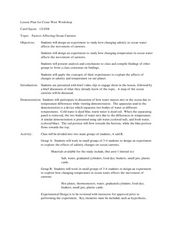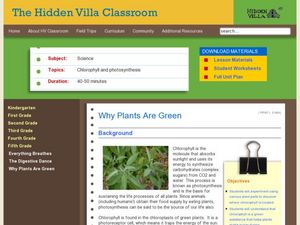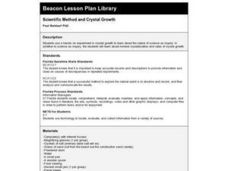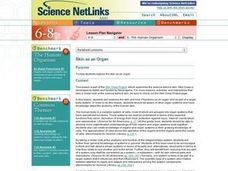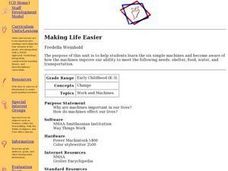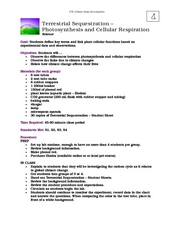Curated OER
Factors Affecting Ocean Currents
Students design and conduct an experiment to determine the effect of salinity and temperature changes in the movement of ocean currents. For this earth science lesson, students record observations and collect data. They share their...
Curated OER
Tornado In A Bottle
Students are able to visualize a tornado usig a simple experiment. They are divided into small groups. Students drill a 3/8 inch hole in the center of each bottle cap. Students connect the caps to the top of each other using glue. ...
Curated OER
Under the Sea Webquest
Fourth graders work in small groups to research a selected species of ocean creature. They conduct Internet research, complete a WebQuest and worksheet, and complete a group oral presentation that includes an illustration of the food...
Curated OER
Lemon Batteries Revised
Fifth graders investigate how chemical energy in food and batteries is potential or stored energy. They discuss how batteries function, and create a class list of different forms of energy. Students then create a lemon battery that...
Curated OER
Denaturing Proteins
High schoolers investigate how to denature proteins. In this denaturing protein lesson plan, students explore the different ways to denature proteins in the lab. They use heat, acids and bases, organic compounds and heavy metals to...
Curated OER
States of Matter: Solids, Liquids and Gases
Students explore various states of matter. In this science lesson plan, students recognize the properties of each state of matter and recognize the similarities and differences between the three states of matter.
Curated OER
The Real Deal on the Digestive System
Sixth graders explore the human body by viewing video clips. In this digestive system lesson plan, 6th graders discuss what they think happens when they swallow food. Students view a Brain Pop clip demonstrating the digestion of food and...
Curated OER
Why Plants Are Green
Students discover the properties of chlorophyll in plants. In this plant biology lesson, students conduct an experiment to find where the chlorophyll in the plant is located. Students are split into small groups and study plant parts....
Curated OER
Too Cool for School-The Greenhouse Experiment
Students create a town model and analyze the type of greenhouse gases their town emits. In this earth science lesson, students build greenhouses to investigate how trapped heat causes temperature change. They relate this activity to...
Curated OER
Sources of Energy
Students research various methods for preparing food and analyze energy sources. They explain that radiation, light, and heat are forms of energy used to cook food, treat diseases, and provide energy.
Curated OER
A Whale of a Difference
Students research various perspectives on Japan's commercial whaling industry and formulate position papers representing these views. They read the Times article, Yuk! No More Stomach for Whales. Groups present their perspectives on...
Curated OER
Putting Toxicogenomics To The Test
Learners evaluate the pros and cons of a new approach to food, chemical, and drug testing. They read and discuss the Times article, 'DNA Chip May Help Usher In a New Era of Product Testing.'
Curated OER
Scientific Method and Crystal Growth
Students conduct a hands-on experiment growing crystals to demonstrate the nature of science as inquiry. They discuss and test variables that affect crystal growth. They research mineral crystallization and mineral formation on the...
Curated OER
Water, Water Everywhere (Pond Animals)
Second graders examine the characteristics of animals who live in a pond environment. In groups, they describe the various stages in the life of a frog and identify the characteristics of other pond animals. Using this information,...
Curated OER
Standard 4 Review Sheet-Key Ideas Biology-The Living Environment
In this living environment worksheet, students answer a variety of questions about living organisms, the processes they go through to make food and break down food, absorb nutrients, and release toxins. They explain homeostasis, they...
Curated OER
The Dinosaur Diner
Students explore the food chain. In this dinoaur lesson, students identify charactersitics of an omnivore, carnivore, and herbivore. Students sort dinosaur picture/word cards into groups by their eating characteristics. Students also...
Curated OER
Meet the Plants
Students examine the difference between living and non-living things. In this living versus non-living lesson, students complete a KWL worksheet and a Living and Non-Living Chart. They examine a variety of plants and non-plants before...
Curated OER
Old Growth Forest Mural
Students explore the four characteristics of an old growth forest. In this forest lesson plan, students research old growth forests and their inhabitants. Students work in four separate groups and create a mural for their characteristic...
Curated OER
Mole Relations
Tenth graders investigate the mole using raisins, sunflower seeds and M&Ms candy. In this mole relations lesson plan, 10th graders create trail mix packets using the food items given to them using "dozen" as the units. Students write...
Curated OER
Skin as an Organ
Students are introduced to human skin as an organ of the body with many roles, functions and interactions with other organs. They investigate the integumentary system in groups and complete a worksheet with their findings.
Curated OER
The Aquatic Environment
Fifth graders focus on the various types of fish living in different water environments. In groups, they research the different methods used to fish and participate in experiments to determine the effects of mercury on fish, the...
Curated OER
Making Life Easier
Students use a chart of the six simple machines and become aware of how the machines improve our ability to meet the following needs: shelter, food, water, and transportation. Students use model cars to experiment with force. They divide...
Curated OER
Animal Alphabet
Second graders identify animals with each letter of the alphabet. In groups, they create a PowerPoint presentation which shows the information they have collected about each one. Using all of this information, they create an animal...
Curated OER
Terrestrial Sequestration- Photosynthesis and Cellular Respiration
Students examine the differences between cellular respiration and photosynthesis. For this cellular processes lesson students complete a group lab activity to see how climate change affects their lives.


